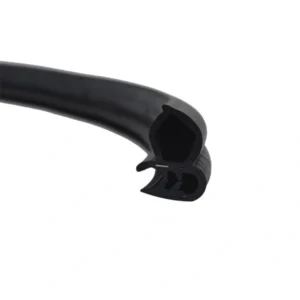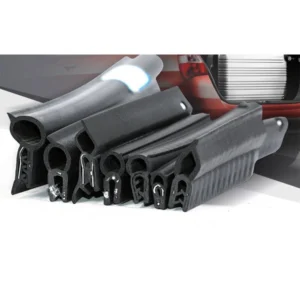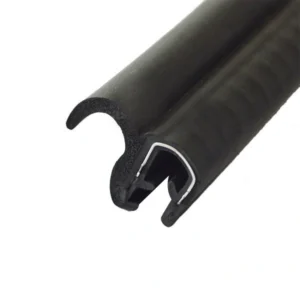Cars, machines, and buildings often experience various threats. Some of the critical external threats are mechanical impact and vibrations. A rubber pinch weld can help you prevent them.
Rubber pinch weld seals can be used in various applications. These include protecting edges, reducing shocks, sealing against water, and more. In this article, we will briefly discuss these uses. So, let’s get started.
What is a Rubber Pinch Weld?
A rubber pinch weld is generally a sealing component. It protects cushions and strengthens edges, seams, and parts at risk. It mostly stops mechanical impacts, vibrations, and other threats from the outside.
A pinch weld rubber seal is usually made of synthetic rubber. In most scenarios, it has either a hollow or solid core. Metal or fabric inserts can add additional strength. However, the outside has a ribbed structure for better grip and sealing. Finally, grooves inside may make attaching and sticking to surfaces easier.
Several types of pinch weld seals are available in the rubber industry. Common variations are edge protector, flap door seal, boot seal, and U-section bulb trim. Each type is suitable for specific use.
What is the Difference Between a Rubber Pinch Weld and A Rubber Seal Strip?
A rubber pinch weld and a rubber seal strip serve different purposes. They each have their own traits. In different situations, though, both are used for sealing.
The primary purpose of rubber pinch welds is to protect edges and provide cushioning. They are commonly used on car doors, hoods, and windows. Their structures are usually more complicated.
Conversely, rubber seal strips make a tight seal between two surfaces. They typically prevent moisture, dust, air, or chemicals. Most of the time, they have simpler structures. To make fitting easier, seal strips may have an adhesive back. They are often found in door and window seals, vehicle weather stripping, and HVAC systems.
| Feature | Rubber Pinch Weld | Rubber Seal Strip |
| Purpose | Edge protection, reinforcement, cushioning | Creating a tight seal between surfaces |
| Structure | Complex, with flexible rubber and inserts | A simple, continuous strip of rubber |
| Reinforcement | Often reinforced with metal or fabric | It may or may not reinforced |
| Outer Surface | Ribbed or textured for grip | Uniform profile |
| Inner Surface | It may have grooves for attachment | Generally smooth |
| Application areas | Vehicle doors, hoods, windows | Automotive weatherstripping, door seal seals, HVAC |
| Installation method | Attached to a substrate with clips of fastened | Often features adhesive backing |
Rubber Pinch Weld Roles in Different Applications
Rubber pinch welds are prevalent in many situations. The following ten situations are the most common. We may often observe the use of pinch weld seals in many industries. Let’s check them out.
Role #1 Edge Protection
Edge protection is crucial to keep many goods and tools from getting damaged. This damage may happen due to impact or abrasion along their edges. Edge protection is also necessary for the safety of the people. For example, sheet metal edges can be dangerous.
Rubber pinch weld solves this problem excellently. It provides a robust barrier against impact and abrasion.

We may often find it in many applications. For example, rubber pinch weld is frequently used to protect the doors and windows of cars in the auto industry. In the construction industry, pinch weld seals are used on the edges of metal or glass panels.
Role #2 Sealing & Gasketing
Rubber pinch welds also play a crucial role in sealing and gasketing. Unlike seal strips, a pinch weld door seal specifically seals gaps, edges, and joints. You may often find them in cars, buildings, and machines.

Please remember that seal strips mostly keep out water, air, and noise. On the other hand, a rubber pinch weld creates a secure seal around edges, seams, and openings. Pinch weld sealing is often found in your car’s doors, windows, and hatches.
In this case, seal strips and pinch welds may be similar. Both create a reliable barrier against water, dust, noise, and vibration.
Role #3 Vibration Dampening
Vibration is a serious problem in machinery. It may create many problems. For example, vibrations cause equipment to wear out early. If they wear out too quickly, they will need more repairs and cause more downtime.
In addition, vibrations can create discomfort in vehicles or buildings. Car engines and HVAC systems in buildings are noteworthy examples. In the factory, vibrations can make machines less accurate and precise.
A rubber pinch weld plays a crucial role in vibration dampening. It can absorb and spread vibrations.
A rubber pinch weld increases the lifespan of the machine or vehicle. Overall, it enhances comfort and reduces cost.
Role #4 Shock Absorption
Shock absorption protects both the equipment and the things that it works with. Different kinds of shocks could happen. Impacts, vibrations, and sudden changes in loads or moves are all common examples. These shocks can lead to damage, malfunctions, or even safety hazards.
Rubber pinch welds are significant for absorbing shock. They act as cushions between different parts or surfaces. Because rubber is elastic, it can change shape when affected by pressure. It handles the energy from the shocks well by absorbing and spreading it.
In addition, rubber pinch weld can keep working well. Over time, it reliably absorbs pressure, even when hit many times.
Role #5 Waterproofing
Rubber pinch welds are very effective at keeping water out. The unique form of the material prevents water from reacting with the other surface. Also, because it is flexible, it can fit over rough surfaces. It usually covers the whole area and prevents water from getting in, even in harsh conditions.
Waterproofing is essential for machines and equipment. Water can damage sensitive parts, and rubber pinch welds prevent this damage. Water getting into the factory can cause several problems. Common problems are mechanical failure, corrosion, and electrical malfunctions. In the long run, it generally leads to costly repairs.
Role #6 Sound Insulation
Noise or unwanted sound can create discomfort. It may also be a sign of potential hazards in a system. Sound insulation is typically necessary for these situations.
Rubber pinch welds can effectively reduce noise. They absorb and dampen sound waves. When installed along edges or gaps, they form a barrier that prevents sound transmission.
For example, in architecture, rubber pinch weld seals are used around doors and windows. They usually block out outside noise and make the inside of a room peaceful. Similarly, they close gaps in car doors or trunks in automobiles. This reduces noise from the road and makes the cabin more comfortable for guests.
Role #7 Heat Insulation
We often need heat insulation material for safety and comfort. Machines need it to work well. It is also necessary to protect sensitive equipment. Heat protection in cars keeps people from getting too hot or too cold.
Heating insulation also saves energy in homes and public areas. It keeps heat from moving through the roof, walls, and windows as little as possible. Overall, it lowers the cost of heating and cooling.
Rubber pinch welds can withstand varying heat levels. Rubber has excellent flexibility, so it works great for a long time. Different types of rubber serve various purposes.
Role #8 Dust Prevention
Dust accumulation can pose risks to health and safety. For machinery, this can lead to malfunction. As a result, keeping dust away is very important. Several fields need this to ensure the quality of their products and the health and safety of their workers. You may often see it in manufacturing, electronics, and food processing factories.
A rubber pinch weld plays a crucial role in dust prevention applications. It forms strong barriers and seals. This tight seal usually keeps dust from getting into enclosed areas.
Rubber pinch weld ensures cleaner environments. It also reduces the need for frequent cleaning and maintenance.
Role #9 Automotive Pinch Weld Edge Trims
Automotive edge trims improve car safety. Pinch weld edge trims are applied along the edges of doors, windows, hoods, and trunks.
These trims provide a clean and finished look. Besides, they protect your car from impacts, scratches, and corrosion.

Pinch weld edge trims make installation around curved surfaces easy, ensuring a snug fit and adequate protection.
Pinch weld trims last long and don’t break down in high or low temperatures, UV rays, or water. Because of this, they are perfect for protecting edges for a long time.
However, based on the different positions of a vehicle, the type of pinch weld edge trim varies.
Role #10 Gripping
Gripping is the ability to hold onto or grasp an object. Secure gripping is crucial in various scenarios. It ensures safety, stability, and control over objects.
Rubber pinch welds typically have a high-quality grip. They offer excellent cushioning and a non-slip surface, allowing users to hold them and lift objects comfortably.
Let’s say you are working with heavy metal sheets. The edges of metal sheets can pose risks to your safety. But if you have pinch welds, you can securely lift these heavy metal sheets. Industrial applications provide more examples.
Summary
Let’s wrap everything up! A rubber pinch weld is a crucial car, building, or machine element. It has many applications, of which we have discussed the ten most popular uses in the preceding sections. It offers edge protection, sealing, shock absorption, vibration dampening, and more.
If you explore rubber pinch welds further, you will find a wide range of types and materials. Because of this, choosing suitable options becomes tricky. Therefore, considering the application requirements is very important.
Seashore Rubber is a leading manufacturer of various rubber seal strips. Rubber pinch welds are one of their busy production. If you need more information, you can contact our customer support team. We have a team of professionals who are always happy to assist you.
